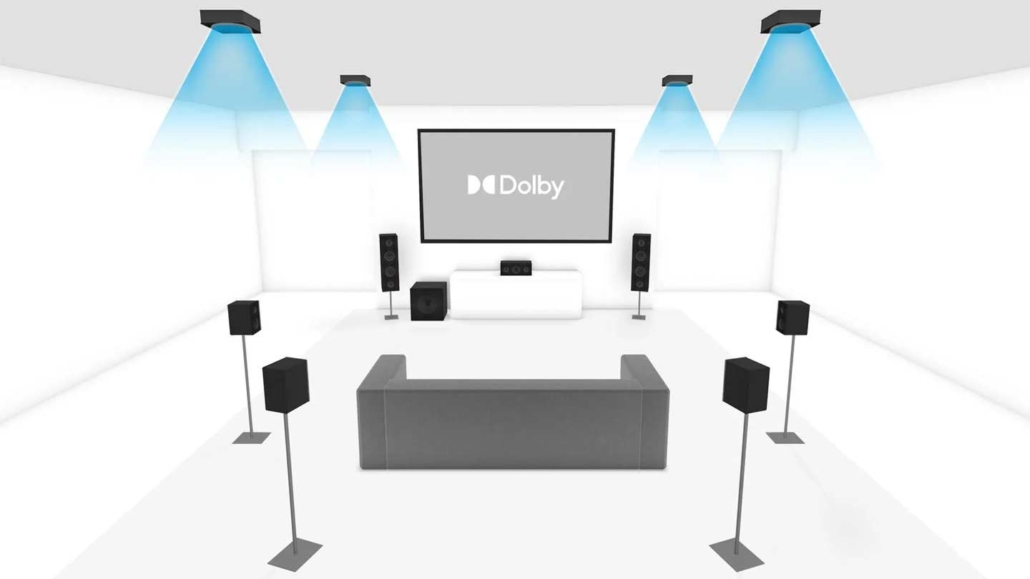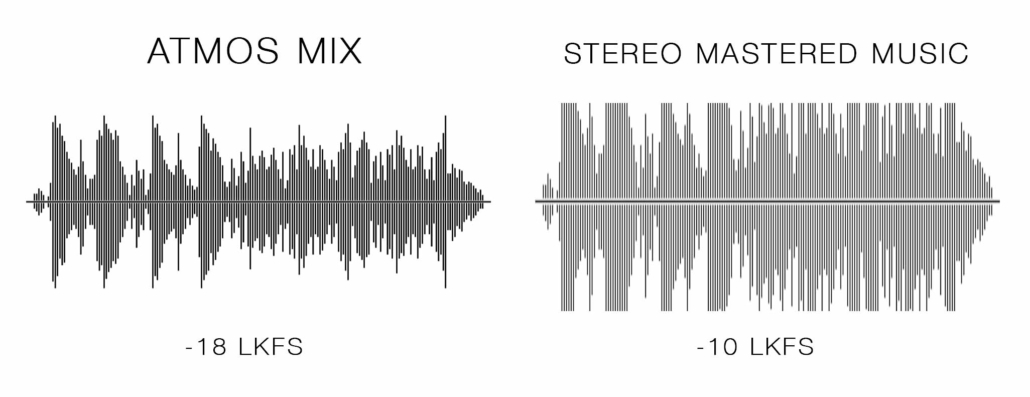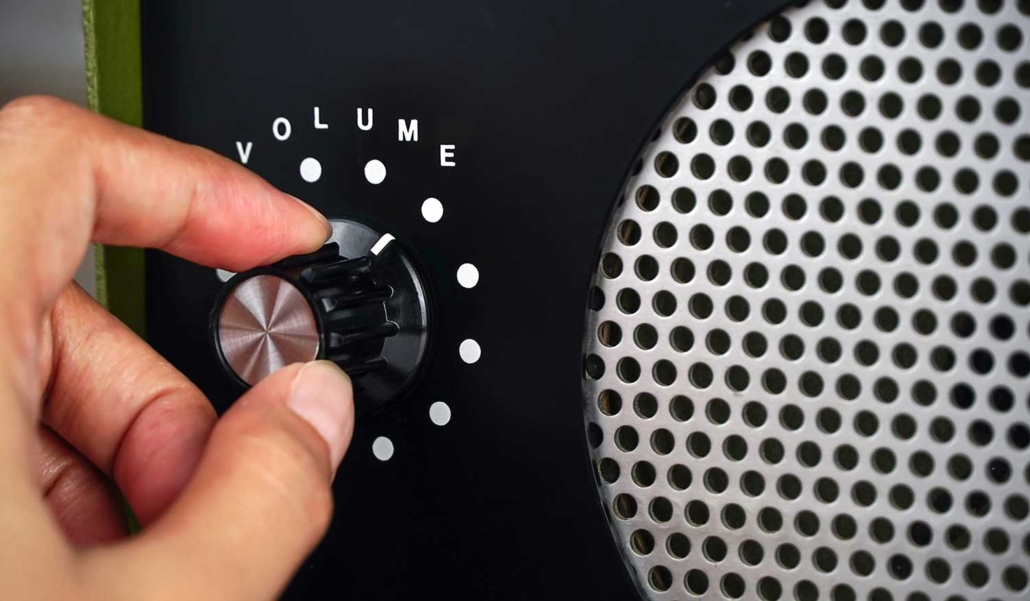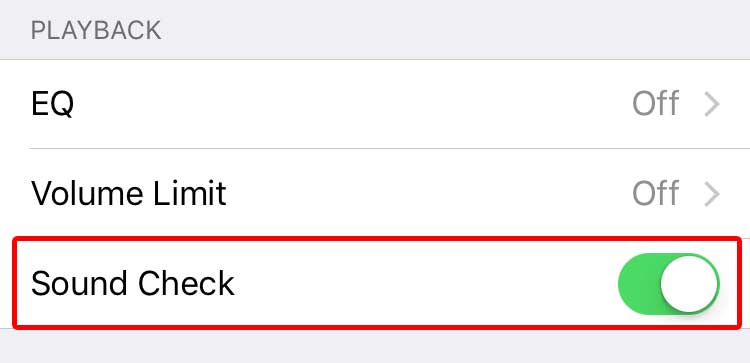Why is Dolby Atmos quieter than other music audio formats? And why it’s a good thing
There’s a common reason why Dolby Atmos mixes are at a lower volume than other songs mastered in stereo. The answer is that it was created specifically for cinema and home theater environments.
This immersive audio format employs a multi-speaker setup. Atmos can have a full configuration of up to 24 speakers on the floor and 10 additional overhead speakers. Just like other surround sound formats, this dynamic arrangement contributes to an unparalleled audio experience that envelops you in sound while maintaining a controlled volume level.
Speaker Setup and Utilization
The number of speakers directly contributes to the perceived loudness. When you have more speakers, the sound becomes even more powerful and impactful while the volume is set lower than a stereo set up.
For example, having two speakers will result in a louder output than just one speaker. Similarly, four speakers will create an even greater level of volume compared to having only two, and so on.
With the utilization of a surround sound speaker setup, you can create an immersive audio experience without needing to blast the volume. This means you can achieve excellent dynamic range and still enjoy every detail.
However, it’s important to note that when downmixed to stereo, the audio may be noticeably quieter than a professionally mastered stereo track designed specifically for music. This can be very noticeable on headphones when switching between the two formats.
What is Dolby Atmos and how does it work?
Dolby Atmos, was introduced in 2012 with the release of Disney Pixar’s “Brave”, has now reached its milestone of a decade in existence. As a groundbreaking innovation, this spatial audio system revolutionized the cinema experience with its immersive surround sound.
Unlike traditional audio formats that operate within a fixed channel-based system, Dolby Atmos utilizes object-based audio technology. This means that instead of assigning specific sounds to specific channels, Dolby Atmos allows for individual sounds to be treated as objects in a three-dimensional space. These objects can then be precisely placed and moved within the listening environment, creating a truly immersive and realistic soundstage.

Dolby Atmos 7.1.4Setup. via dolby.com
One of the key advantages of this object-based approach is the ability to maintain a wider dynamic range. Dynamic range refers to the difference between the softest and loudest sounds in an audio recording. By allowing for greater control over individual sounds and their placement within the three-dimensional space, Dolby Atmos enables more nuanced and detailed audio reproduction.
In practical terms, this means that Dolby Atmos can deliver both subtle whispers and thunderous explosions with exceptional clarity and precision. The quieter moments are rendered with delicate subtlety while still preserving all the intricate details of the original recording. Dolby Atmos allows for an exhilarating level of impact without compromising on clarity or fidelity.
Dolby Atoms Was Not Originally Developed for Music Releases
In today’s music production landscape, Atmos Music releases have become more than just a trend – it has become an essential part of the process. The idea of experiencing your favorite artist’s song in an immersive audio environment is truly captivating and adds a whole new level of enjoyment to the listening experience.
It is worth noting that Dolby Atmos was initially not intended for complete music mixes and albums, but rather for the film and cinema industry. As a result, the audio level standards are adhered to in the world of theatrical film.
Music studios and labels later found Atmos as a new platform to showcase their artists’ songs in a brand-new way. However, it is still necessary to adhere to the lower-level audio standard. Thus, the audio level difference between the two.
Imagine if the Atmos mix was mastered at the same level as maximized stereo content. The sheer volume would be overwhelming, and you’d risk blowing off your ears! It’s crucial to ensure a balanced audio experience that doesn’t compromise on quality while maintaining a comfortable listening level.
The End of the Music Loudness War?
Over the past 20 years, we have become accustomed to the loudness war in stereo-mixed music. However, Dolby Atmos Music has brought about a significant change with its new audio level standard of -18 LKFS as opposed to the average stereo master audio of -10 LKFS/LUFS. This standard aims to enhance the listening experience by allowing for a greater dynamic range.
Under this new standard, mixes cannot exceed an average of -18 LKFS for the entire program material. This has put an end to the loudness war in the realm of immersive audio experiences.

The image above is a representation of the dynamic range for music in Dolby Atmos compared to traditional stereo masters. Stereo mastered music will always be louder in volume as it is compressed and maximized for the highest output possible.
With the implementation of this strict boundary serves a valuable purpose: ensuring that Atmos remains enjoyable for all listeners by preventing excessively loud volumes. Additionally, it also serves as an encouragement for audio mixers to embrace a more dynamic and nuanced approach to their work.
Turning up the Volume
The lower volume level may require listeners to turn up their system to achieve the same average loudness as previous stereo releases. However, this adjustment improves sound quality and clarity compared to traditional stereo mixes.
In the realm of music, we have become accustomed to the excessively amplified sound that pushes volume to the limits in stereo music releases and MP3s. The goal is to create the loudest track possible without sacrificing the dynamics.
With the new trend of music being mixed on Atmos, the music must be mixed according to the new volume limitation standards. Consequently, this makes the master lower overall.
In recent years, music streaming and distribution platforms have made Atmos Music and immersive audio a staple for their titles. You can now find Atmos versions of songs and music albums on platforms like Apple Music, Tidal, Spotify, and Amazon Music.
Can an Atmos mix go over -18 LKFS during the duration of the mix?
The short answer is yes. However, it is recommended not to exceed -18 LKFS by more than a couple of dB throughout the mixed content.
It is important to remember that the -18 LKFS standard is not for the true peak, but rather for the “Integrated” average of the entire program material. This means that LKFS is calculated by averaging the volume of the entire song or film. The highest peak level should be -1 dBTP or less and never go above.
How to Remedy Low Volume Over Dolby Atmos
-

Image by Freepik.com
Increase the volume on the receiver or device playing the Dolby Atmos content. Remember to keep in mind to adjust the volume between surround sound and music.
- Enable the ‘Sound Check’ feature in the music settings to normalize volume across all audio on Apple devices.
- Disable Atmos metadata to receive surround sound in Dolby 5. 1 and 7. 1.
- Adjust the audio settings on both the TV and receiver.
- Mark the volume level on the receiver for both Atmos and regular stereo-mastered music. You can easily adjust the volume between these two settings.
Enable the ‘Sound Check’ feature for Apple users
You can enhance your music experience by enabling the ‘Sound Check’ feature in your music settings. This nifty feature ensures that the volume of all audio is normalized, so you can enjoy consistent and balanced sound quality across your favorite tunes.
On your Apple playback device, you can enable the Sound Check’ setting. This will normalize all the audio playing back on the device to be at the same level.
-
“Music” app > “Settings” > toggle on “Sound Check“
 Disable Atmos
Disable Atmos
If you’re experiencing low volume and don’t mind sacrificing the Atmos metadata, you can try disabling Atmos and just use the surround sound (Dolby 5.1 and 7.1) instead.
Conclusion
In conclusion, the apparent quietness of Dolby Atmos is not only intentional but also serves as one of its greatest strengths. Through its innovative approach to spatial audio technology, Dolby Atmos delivers a captivating and immersive listening experience. By providing precise control over sound placement and dynamics, it enhances the overall quality, depth, and realism of audio content.










